Overview of Mayapple
Mayapple is a native woodland plant that is widespread across most of eastern North America south to Texas in zones 3 to 8. Podophyllum peltatum is the only species in this genus in the barberry family (Berberidaceae). This herbaceous perennial typically grows in colonies from a single root in open deciduous forests and shady fields, riverbanks and roadsides. All the parts of the plant, except the fruit, contain podophyllotoxin which is highly toxic if consumed, but was used by Native Americans for a variety of medicinal purposes. Podophyllotoxin is an ingredient in prescription drugs.
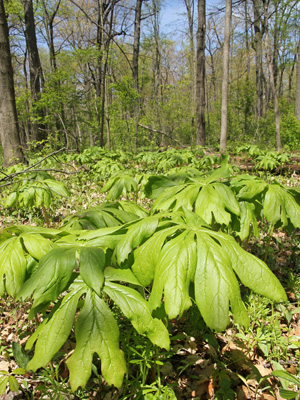
The upright stems grow from a shallow, creeping, branched underground rhizome, composed of many thick dark or reddish-brown tubers connected by fleshy fibers and downward spreading roots at the nodes. Each terminal bud produces a shoot. The mostly unbranched, 12-18-inch-tall stems are topped with umbrella-like (peltate) leaves.
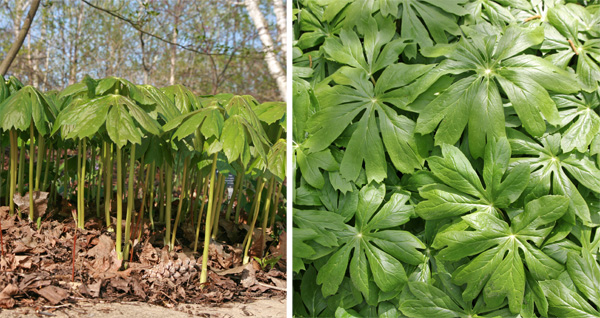
The leaves remain furled as the stem elongates in the spring, unfolding when the stem nears its full height. Each smooth, pale green, rounded, palmate leaf has 5-9 shallowly to deeply cut lobes. There are one or two leaves per stem, each up to a foot across. Only stems with more than one leaf will flower. Mayapple often forms large, dense colonies in the wild.
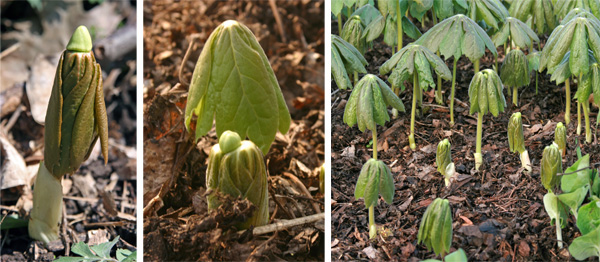
As with many native spring wildflowers, mayapple emerges in early spring before trees produce leaves and then senesces to go dormant by mid-summer. Shoot senescence is affected by both the vigor of the rhizome system and environmental conditions (the sunnier the location the earlier it goes dormant).
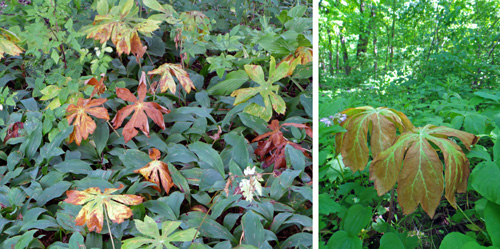
Flowering stems produce solitary flowers in the axil of the two leaves. The nodding, white to rose-colored flowers appear in April or May. Each flower is 2-3 inches wide, with 6 light green sepals, 6 to 9 waxy petals, and twice as many stamens with white filaments and yellow anthers. Although the flowers are quite showy, they are short-lived and usually hidden by the leaves. The flowers are fragrant, variously described as pleasant to putrid and are visited by bumblebees and other long-tongued bees.
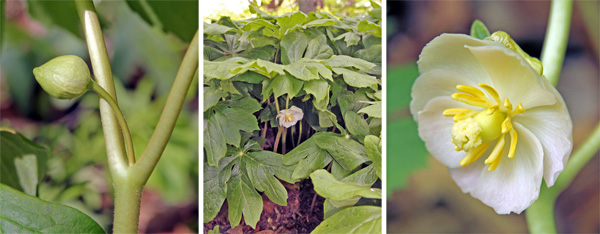
Pollinated flowers are followed in early summer by fleshy, ovoid to lemon-shaped fruits (a berry) containing several tan seeds. These green “apples” ripen to a golden color, sometimes tinged with pink or purple, later in the summer. The 1½-2 inch long fruits (but not the seeds) are edible (but bland) when ripe and can be used in jellies or preserves. They may also be eaten by box turtles and other wildlife that disperse the seeds. Plants will self-seed under ideal growing conditions.
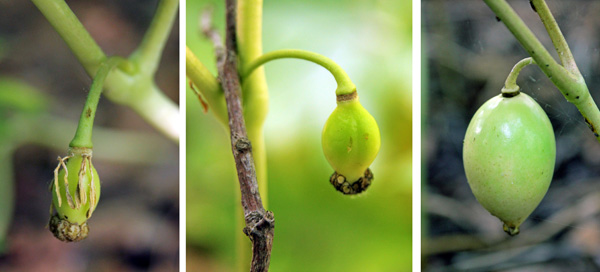
Landscape Use
These native wildflowers are often grown as ornamental plants for their attractive foliage and flowers. They are perfect for naturalizing in a woodland garden or native plant garden. This plant is rarely used in borders, as it goes dormant in the summer, leaving a large gap that is difficult to fill, and does not like competition. Mayapple is juglone tolerant and will grow under black walnut and is not eaten by deer or rabbits.


General Care & Propagation of Mayapple
Mayapple needs partial or full shade to thrive and prefers rich, moist soil with abundant organic matter. It can be propagated by division of the roots when dormant (in late summer or fall or very early spring) or from seed.
Seeds should be planted immediately (stored seed will require three months of cold-moist stratification) and seedlings take 4-5 years to mature. There are some uncommon variations in the species. P. peltatum forma deamii has pink, rose, or purple flowers followed by maroon or red fruits. Even more rarely plants produce a cluster of fruits (forma polycarpum).
– Susan Mahr, University of Wisconsin – Madison
Last Update: Bruce Spangenberg, UW-Madison Extension, 2025





 Aster, Symphyotrichum spp.
Aster, Symphyotrichum spp. Fascinating Fasciation
Fascinating Fasciation Alternatives to Lawn: Groundcovers
Alternatives to Lawn: Groundcovers Marigolds
Marigolds


